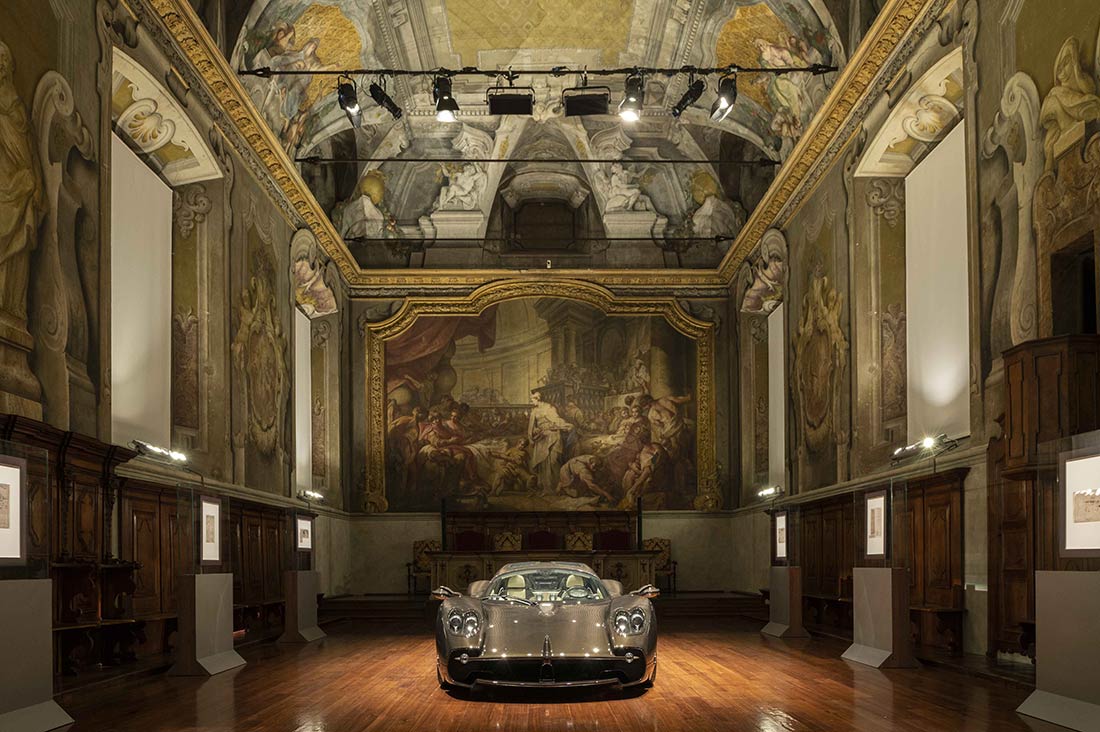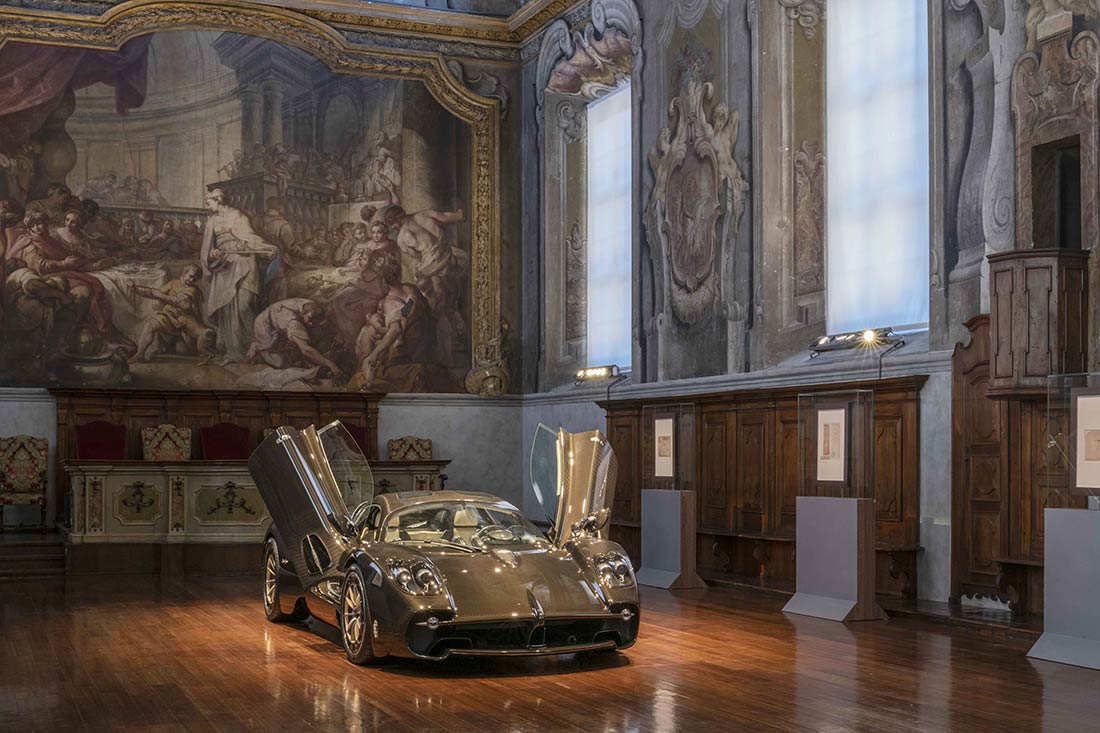- Estreno mundial del nuevo Hypercar de Pagani en el espléndido escenario de la Sala del Cenacolo del Museo
- Seis dibujos originales de Leonardo da Vinci, cedidos con carácter excepcional por la Biblioteca Ambrosiana, sirven de telón de fondo a la Utopía Pagani
- Para la inauguración, una exposición especial “La forma del aire: de Leonardo a la utopía de Pagani” curada científicamente por Pietro C. Marani, autor de numerosas publicaciones sobre el artista. Una doble exploración de los estudios sobre el aire del erudito italiano y la génesis de la Utopía Pagani
- Un elemento común: la estrecha conexión entre Arte y Ciencia, el principio Leonardiano que inspira la filosofía de Horacio Pagani, Pagani Automobili Founder & Chief Designer

PAGANI UTOPIA unveiled at the national science technology museum in milan surrounded by original drawings by Leonardo Da Vinci
Milán, 13 de septiembre de 2022 – El Museo Nacional de Ciencia y Tecnología de Italia en el centro de Milán es el lugar para el debut oficial del nuevo Pagani Hypercar, el vehículo que escribirá el tercer capítulo en la historia de la marca, con el título: Pagani Utopia. En el espléndido marco de la Sala del Cenacolo, rodeada de dibujos originales de Leonardo da Vinci, la última creación del taller de Módena diseñada por Horacio Pagani encarna una visión utópica y visionaria del automovilismo, un concepto no convencional separado románticamente del significado contemporáneo de automóvil. Y lo hace en el más puro espíritu Pagani, donde el elemento rector que sustenta los coches de la compañía siempre ha sido el principio de Arte y Ciencia de Leonardo.
No se podría haber elegido un lugar mejor para presentar a la recién llegada: Milán, la ciudad cosmopolita que fue el hogar del artista, y el Museo que alberga las Galerías Leonardo, la exposición permanente más grande del mundo sobre Leonardo da Vinci, ingeniero, humanista y estudioso de la naturaleza.

PAGANI UTOPIA unveiled at the national science technology museum in milan surrounded by original drawings by Leonardo Da Vinci
“A la entrada del Museo, el visitante es recibido por una frase de profundo significado: Scienza è Cultura – La ciencia es cultura. La expresión representa la esencia misma del Museo como lugar dedicado a Leonardo da Vinci y, como el propio artista, condensa las interrelaciones entre diferentes pero complementarias ramas del saber que, juntas, ayudan a comprender la realidad. Este diálogo entre arte, ciencia y tecnología es un rasgo distintivo de la identidad del Museo. Además, el descubrimiento y la invención que nunca dejan de sorprendernos se combinan con la capacidad fundamental de diseñar y construir, dando así un valor concreto al ingenio humano”, dice Fiorenzo Galli, Gerente General del Museo Nacional de Ciencia y Tecnología.
Reforzar los lazos entre el diseño de Pagani Hypercars y Leonardo da Vinci es un préstamo excepcional de la Biblioteca Ambrosiana, que, para la presentación del nuevo coche, ha concedido permiso para que seis dibujos originales de los estudios de Leonardo sobre el aire, salgan de sus bóvedas en una base temporal para la exposición “La forma del aire: de Leonardo a Pagani Utopía”.

PAGANI UTOPIA unveiled at the national science technology museum in milan surrounded by original drawings by Leonardo Da Vinci
Comisariada por Pagani Automobili y Pietro C. Marani, un destacado experto en Leonardo da Vinci y autor de numerosos libros sobre el artista toscano, la exposición ofrece a los visitantes la oportunidad de una exploración dual. Por un lado, el asombroso genio de un hombre con la capacidad -hace seis siglos- de representar hasta lo invisible, plasmado en una colección de hojas del Codex Atlanticus sobre el estudio del aire y sus aplicaciones; por otro, el pensamiento que llevó al diseñador Horacio Pagani y su equipo a concebir el proyecto Utopía. Una visión binaria de forma y función.
“La presentación de nuestro nuevo automóvil en el marco extraordinario del Museo Nacional de Ciencia y Tecnología de Milán tiene un significado especial”, dice Horacio Pagani. “Leonardo fue muy creativo aquí en Milán, donde disfrutó de un período maravilloso. Ha sido una gran influencia en mi vida desde que era un niño, es la inspiración de los conceptos fundamentales de Arte y Ciencia que guían nuestro trabajo. Así que estar en el museo que lleva su nombre y tener sus dibujos originales al lado de nuestro auto es una emoción verdaderamente indescriptible para mí”.

Los visitantes podrán rastrear la génesis del proyecto Pagani Utopia en una serie de paneles especiales: desde las fuentes de inspiración hasta los primeros bocetos del automóvil, la paleta de colores y los materiales utilizados, condensados en un moodboard tridimensional. La ruta creativa llega a su punto culminante en la Sala del Cenacolo para ver de cerca el nuevo Pagani Hypercar. Desde el exterior, una carrocería de líneas suaves y elegantes construida en materiales compuestos de alta tecnología; en el interior, el poderoso corazón del motor Pagani V12.
Los seis dibujos originales de Da Vinci seleccionados por Marani proporcionan el marco ideal para la nueva Utopía de Pagani. Seis obras que ponen de manifiesto cómo el artista supo representar lo invisible, plasmar “la existencia de la nada”, esa infinita extensión intersticial que envuelve todos los cuerpos, en contacto con el aire. Junto con el agua, el aire es uno de los cuatro elementos (incluidos la tierra y el fuego) que más intrigaron a Leonardo, cuyos movimientos y manifestaciones se esforzó en retratar.
“Un hilo conecta las observaciones de Leonardo y sus conocimientos sobre aerodinámica con las creaciones de Horacio Pagani”, comenta Pietro C. Marani. “Es como si el diseñador finalmente hubiera dado forma concreta a lo que Leonardo simplemente intuyó sobre la forma en que el aire ‘forja’ y esculpe formas, que se puede ver, por ejemplo, en los dos dibujos de fortalezas de la exposición”.
La exposición se enriquece con una sección titulada “Historia de un sueño”, la aventura del joven Horacio Pagani que llegó a Módena desde Argentina con una ambición: crear los autos más bellos del mundo. Los invitados podrán juzgar por sí mismos si ese sueño se hizo realidad: en los claustros, junto con el nuevo Pagani Utopia, se exhibirán dos modelos históricos -el Zonda C12 (1999) y el Huayra Coupé (2011)- para contar la historia de una marca que pronto celebrará su 25 aniversario.
El acompañamiento musical de la exposición es una interesante obra sinfónica escrita por el Conservatorio de Milán a partir de las composiciones para piano del joven Horacio Pagani, que ahora es la banda sonora de la nueva Utopía de Pagani.
INFO SOBRE LA EXPOSICIÓN
Museo Nacional de Ciencia y Tecnología Leonardo da Vinci | Via San Vittore 21, 20123 Milán
miércoles 14 – domingo 25 de septiembre de 2022
Horario: martes a viernes de 9:30 a 17:00; Sábado, domingo y festivos 9.30-18.30
Última entrada: 1 hora antes del cierre.
La exposición está incluida en la entrada al Museo
Museum Tickets > https://museoscienza.vivaticket.com/must/landingmuseo.htm
www.museoscienza.org
Pagani Automobili
PRESS CONTACTS
press.office@pagani. com
Christopher Pagani
Luigi Ganzerli
SOCIAL MEDIA
Facebook: facebook.com/PaganiAutomobili
Instagram: paganiautomobili
Youtube: youtube.com/PaganiAutomobili




















